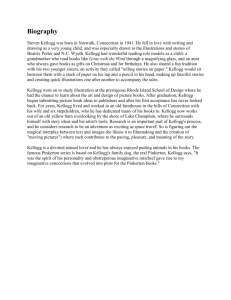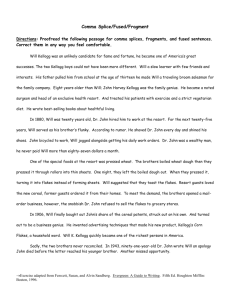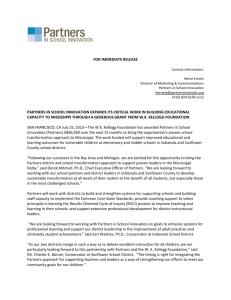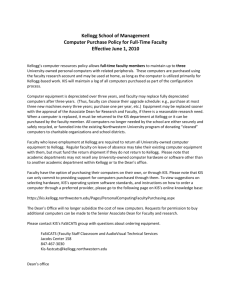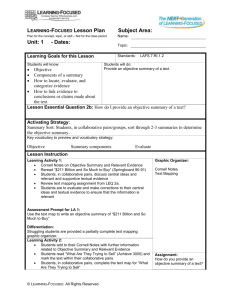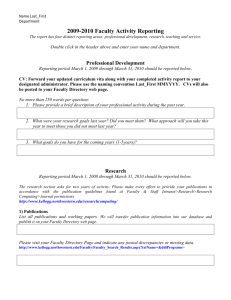Strategic Analysis in MGMT 943
advertisement
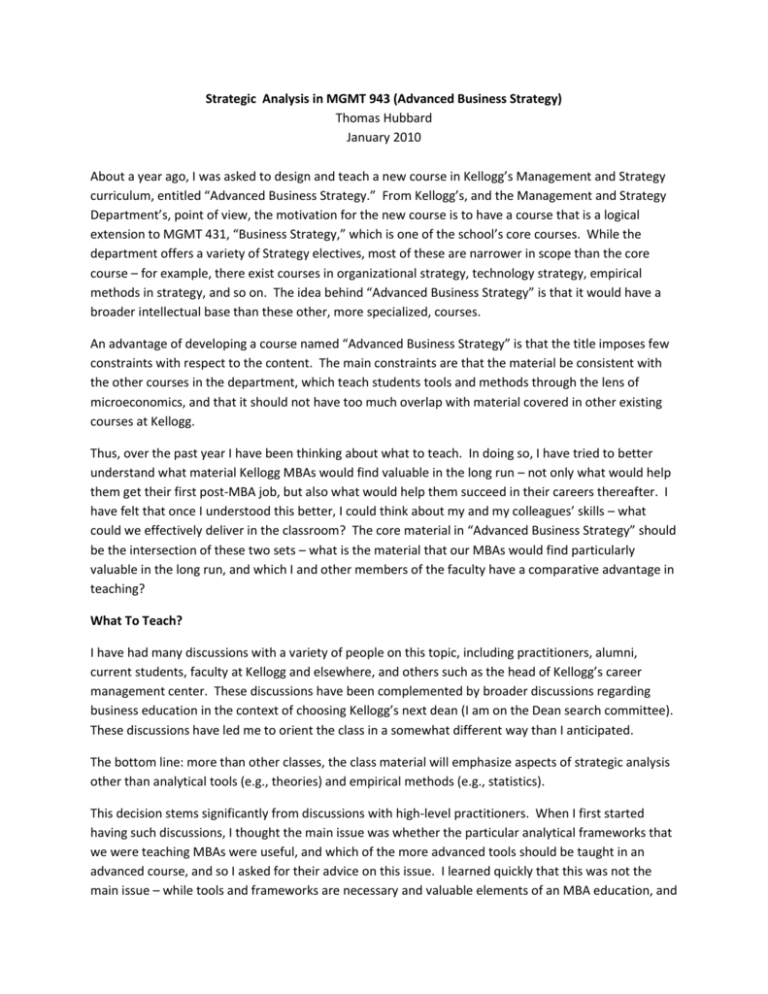
Strategic Analysis in MGMT 943 (Advanced Business Strategy) Thomas Hubbard January 2010 About a year ago, I was asked to design and teach a new course in Kellogg’s Management and Strategy curriculum, entitled “Advanced Business Strategy.” From Kellogg’s, and the Management and Strategy Department’s, point of view, the motivation for the new course is to have a course that is a logical extension to MGMT 431, “Business Strategy,” which is one of the school’s core courses. While the department offers a variety of Strategy electives, most of these are narrower in scope than the core course – for example, there exist courses in organizational strategy, technology strategy, empirical methods in strategy, and so on. The idea behind “Advanced Business Strategy” is that it would have a broader intellectual base than these other, more specialized, courses. An advantage of developing a course named “Advanced Business Strategy” is that the title imposes few constraints with respect to the content. The main constraints are that the material be consistent with the other courses in the department, which teach students tools and methods through the lens of microeconomics, and that it should not have too much overlap with material covered in other existing courses at Kellogg. Thus, over the past year I have been thinking about what to teach. In doing so, I have tried to better understand what material Kellogg MBAs would find valuable in the long run – not only what would help them get their first post-MBA job, but also what would help them succeed in their careers thereafter. I have felt that once I understood this better, I could think about my and my colleagues’ skills – what could we effectively deliver in the classroom? The core material in “Advanced Business Strategy” should be the intersection of these two sets – what is the material that our MBAs would find particularly valuable in the long run, and which I and other members of the faculty have a comparative advantage in teaching? What To Teach? I have had many discussions with a variety of people on this topic, including practitioners, alumni, current students, faculty at Kellogg and elsewhere, and others such as the head of Kellogg’s career management center. These discussions have been complemented by broader discussions regarding business education in the context of choosing Kellogg’s next dean (I am on the Dean search committee). These discussions have led me to orient the class in a somewhat different way than I anticipated. The bottom line: more than other classes, the class material will emphasize aspects of strategic analysis other than analytical tools (e.g., theories) and empirical methods (e.g., statistics). This decision stems significantly from discussions with high-level practitioners. When I first started having such discussions, I thought the main issue was whether the particular analytical frameworks that we were teaching MBAs were useful, and which of the more advanced tools should be taught in an advanced course, and so I asked for their advice on this issue. I learned quickly that this was not the main issue – while tools and frameworks are necessary and valuable elements of an MBA education, and a larger toolkit is better than a smaller one, having a larger toolkit tended not to be what distinguished the most successful practitioners in strategy from less successful practitioners. Instead, what tended to distinguish them were skills such as being able to take complex questions and break them up into smaller, analytically more manageable ones, to bring evidence to bear on a particular question, how to develop hypotheses and form conclusions based on the available evidence. These other skills are highly complementary to the tools and methods that the faculty in the Management and Strategy department and elsewhere at Kellogg currently emphasize in their classes. Unfortunately, they tend to receive less emphasis in MBA curriculums, leaving students mostly to acquire these skills on the job after they graduate. An irony of this is that most aspects in this other set of skills are also extremely valuable in academic research – business school faculty members tend to be very good themselves at these things, though they apply these skills in the context of scholarship rather than in the context of strategic analysis. However, their courses tend to teach tools and methods, rather than these skills, to MBA students. Strategic Analysis -- A Conceptual Framework One way of expressing the general problem of strategic analysis, and the various steps involved, is through the Figure below. Figure 1. Conceptualizing Strategic Analysis. Strategic analysis involves starting from a general strategic question (e.g., “how should the Chicago Tribune change its strategy in light of the steady diffusion of broadband to individuals’ homes?”) and moving to a set of findings and strategic recommendations. The various steps in the analysis include: Breaking the general question into a set of intermediate questions that are more analytically tractable. Analyzing each of these intermediate questions, which involves moving between analytical concepts, evidence, and evidentiary methods. Taking the analyses of these intermediate questions and bringing them together, connecting them to each other and the general questions. This produces a set of findings and strategic recommendations. These generic steps are part of many, if not all, forms of analysis – not just strategic analysis. They are the basis for inquiry in general, and are undertaken by a wide set of individuals who undertake evidence-based analyses including scientists, doctors, lawyers, detectives, investigative reporters, and so on. Strategic analysis, as taught at Kellogg and other top business schools, tends to emphasize certain elements of the analysis; I depict this in Figure 2 below. Figure 2. Most business school courses either teach and illustrate analytical concepts, or empirical methods. Business school courses tend to emphasize two building blocks to strategic analysis – a set of analytical concepts (i.e., theory) and some evidentiary methods (e.g., statistics). These building blocks are undoubtedly important – without them, it is extraordinarily difficult to conduct analysis in a clear and convincing fashion. An important advantage of a “discipline-based” approach to business education where, like at Kellogg and several other top schools, the analytical concepts are organized around academic fields (e.g, economics, psychology, sociology), is that these analytical concepts are wellgrounded in a body of knowledge. Concepts can be discussed with a higher degree of clarity and precision as a consequence, and students can understand not only the analytical tool or framework, but also its proper application and the limits to its usefulness. Similar statements can be made with respect to the advantage of evidentiary methods based on statistical methods – these methods’ scientific roots make their precise application possible. Armed with these tools and methods, students are often given assignments that ask them to conduct a strategic analysis – move from a general question to specific findings and recommendations. This gives them practice with the tools and methods, and a chance to apply them to real-world contexts. This practice is important, and these assignments are valuable as a consequence. However, when reading these assignments as strategic analyses, most fall short. This is unsurprising, because few of the students have received any training with respect to most of the steps in strategic analysis. The Emphasis in Business 943 Business 943 attempts to fill this gap to some extent. While some of the sessions will take the same form as Kellogg’s core strategy course – lectures that introduce new tools, case discussions to provide practice in applying these tools – I will also try to provide more explicit training with respect to elements of strategic analysis other than tools and methods than other courses. We will discuss the problem of acquiring and deploying evidence – the top node of the “triangle” in Figures 1 and 2. We will cover the role that different evidentiary methods can play in an overall analysis, in particular different methods can be used to complement one another. And we will have sessions related to the “arrows” in these Figures: How to take broad strategic questions and break them down into analytically manageable intermediate questions. The arrows in the “triangle”: the importance of a strong fit between analytical frameworks, evidence, and evidentiary methods and how one might achieve it. This would include, for example, thinking about what evidence is appropriate for particular analytical concepts. The discussion will also examine the implications of fit on the content and strength conclusions that one can ultimately draw from the analysis. How to bring together the analysis of the intermediate questions, understanding the roles and connections each of these questions play with respect to the analysis and recommendations. My plan is to provide explicit training along these dimensions through a combination of “workshop” sessions, where I introduce students to the topic and help them work through that step in the analysis in the context of large project that teams will be working on throughout the quarter, and “presentation” sessions where teams present their progress on this step to me and the rest of the class – and I and class members provide oral and/or written recommendations regarding their progress and next steps. Figure 3. The emphasis in Advanced Business Strategy.



